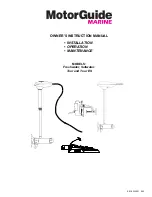
User Manual For Cyclone LC Programmers
112
10.3
Internet Protocol
Once the network has been established, and the IP numbers have been assigned, data can be
transacted over a network with one of several protocols. By far the most prevalent protocol is the
Transmission Control Protocol (TCP), which runs on top of the Internet Protocol in what is
collectively known as the TCP/IP protocol. The TCP/IP protocol was developed by the Department
of Defense to connect different computers from different vendors by a “network of networks,” which
has become what is known as the Internet today.
The primary purpose of the TCP/IP protocol was to prevent a complete network outage in the case
of a nuclear attack, by automatically rerouting data traffic through the functioning part of the
network. As such, the TCP/IP mechanism guaranteed delivery of data packets by introducing a
system of acknowledgments and sequence numbers for the data packets. This mechanism, while
good for transacting large amounts of data (such as email or file transfers), is unsuitable in the
real-time type environment in which the Cyclone operates. Because the Cyclone needs to transact
data as quickly as possible to the target, it takes advantage of TCP/IP’s alternative, the UDP/IP
protocol.
Unlike TCP/IP, the UDP/IP protocol is a connectionless, single-packet protocol that sends short
data packets at the expense of not guaranteeing their delivery. This makes the UDP/IP protocol
efficient in real-time applications such as broadcasting video over the Internet, where the
occasional loss of a frame of data is not going to hamper the overall viewing experience. Left
unmodified, the UDP/IP, with its lack of guarantees for packet delivery, would be unusable in an
environment where the delivery of a single byte of data needs to be guaranteed. The Cyclone
firmware adds mechanisms to the UDP/IP protocol, without affecting its underlying efficiency, to
guarantee delivery of data packets.
10.4
Connecting The Cyclone Device
There are two methods for establishing a connection between a Cyclone and a PC with an
Ethernet cable. The most basic method is to connect the Cyclone directly to a PC, via a cross-over
Ethernet cable. However, the more common method is to place the Cyclone and the PC on the
same network through a Hub.
10.4.1
Connecting the Cyclone to the PC over a network
The Cyclone was intended for use on a network of multiple computers (and other Cyclones). There
are many possible network configurations, and to describe them all is beyond the scope of this
document. However, most configurations are a modification of a basic theme, which is that of
connecting one or more PCs through a Hub to one or more Cyclones.
In order to connect these devices to the Hub, you will need to use the provided straight-through
Ethernet cable. The straight-through cable, which is the “standard” Ethernet cable, is used to
connect devices of different types together, such as a PC to a Hub, or a Hub to a Cyclone.
At this point it once again becomes necessary to program the Cyclone with valid IP numbers, the
process for which is described in greater detail in the following section. However, it is important for
the Cyclone and the PCs to have matching Subnet and Gateway IP numbers, and for each to have
a unique IP number on the network. An example of a setting for above is as follows:
IP Number
Gateway IP
Subnet Mask
PC1
192.168.100.1
192.168.100.3
255.255.255.0
PC2
192.168.100.2
192.168.100.3
255.255.255.0
CYCLONE
192.168.100.4
192.168.100.3
255.255.255.0
Gateway
192.168.100.3
192.168.100.3
255.255.255.0
It is important to briefly touch upon the underlying network architecture, which can be a 10Mb
(Megabit), 100Mb, 10/100Mb, half-duplex, or a full-duplex connection. The details of the underlying
network architecture are beyond the scope of this document, but it is sufficient to note that most
modern network cards, as well as the Cyclone device, have the capability to configure themselves
for the underlying network through the Auto-negotiation mechanism. Auto-negotiation is performed
as soon as a network cable is connected to the device, and it sets the operating parameters of the
Содержание Cyclone FX Series
Страница 1: ...Cyclone LC Programmers User Manual...
Страница 8: ...17 6 Debug Ports CYCLONE LC UNIV 149 17 7 International Shipping 149 17 8 Compliances Standards 149...
Страница 41: ...User Manual For Cyclone LC Programmers 41 Figure 5 2 Main Menu Structure...
Страница 134: ...User Manual For Cyclone LC Programmers 134 4 Click the Add New License button Figure 13 2 Add New License Button...
















































